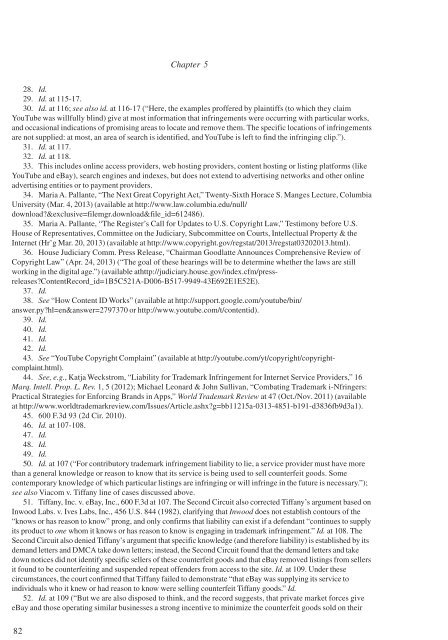1oz61wa
1oz61wa
1oz61wa
You also want an ePaper? Increase the reach of your titles
YUMPU automatically turns print PDFs into web optimized ePapers that Google loves.
Chapter 5<br />
28. Id.<br />
29. Id. at 115-17.<br />
30. Id. at 116; see also id. at 116-17 (“Here, the examples proffered by plaintiffs (to which they claim<br />
YouTube was willfully blind) give at most information that infringements were occurring with particular works,<br />
and occasional indications of promising areas to locate and remove them. The specific locations of infringements<br />
are not supplied: at most, an area of search is identified, and YouTube is left to find the infringing clip.”).<br />
31. Id. at 117.<br />
32. Id. at 118.<br />
33. This includes online access providers, web hosting providers, content hosting or listing platforms (like<br />
YouTube and eBay), search engines and indexes, but does not extend to advertising networks and other online<br />
advertising entities or to payment providers.<br />
34. Maria A. Pallante, “The Next Great Copyright Act,” Twenty-Sixth Horace S. Manges Lecture, Columbia<br />
University (Mar. 4, 2013) (available at http://www.law.columbia.edu/null/<br />
download?&exclusive=filemgr.download&file_id=612486).<br />
35. Maria A. Pallante, “The Register’s Call for Updates to U.S. Copyright Law,” Testimony before U.S.<br />
House of Representatives, Committee on the Judiciary, Subcommittee on Courts, Intellectual Property & the<br />
Internet (Hr’g Mar. 20, 2013) (available at http://www.copyright.gov/regstat/2013/regstat03202013.html).<br />
36. House Judiciary Comm. Press Release, “Chairman Goodlatte Announces Comprehensive Review of<br />
Copyright Law” (Apr. 24, 2013) (“The goal of these hearings will be to determine whether the laws are still<br />
working in the digital age.”) (available athttp://judiciary.house.gov/index.cfm/pressreleases?ContentRecord_id=1B5C521A-D006-B517-9949-43E692E1E52E).<br />
37. Id.<br />
38. See “How Content ID Works” (available at http://support.google.com/youtube/bin/<br />
answer.py?hl=en&answer=2797370 or http://www.youtube.com/t/contentid).<br />
39. Id.<br />
40. Id.<br />
41. Id.<br />
42. Id.<br />
43. See “YouTube Copyright Complaint” (available at http://youtube.com/yt/copyright/copyrightcomplaint.html).<br />
44. See, e.g., Katja Weckstrom, “Liability for Trademark Infringement for Internet Service Providers,” 16<br />
Marq. Intell. Prop. L. Rev. 1, 5 (2012); Michael Leonard & John Sullivan, “Combating Trademark i-Nfringers:<br />
Practical Strategies for Enforcing Brands in Apps,” World Trademark Review at 47 (Oct./Nov. 2011) (available<br />
at http://www.worldtrademarkreview.com/Issues/Article.ashx?g=bb11215a-0313-4851-b191-d3836fb9d3a1).<br />
45. 600 F.3d 93 (2d Cir. 2010).<br />
46. Id. at 107-108.<br />
47. Id.<br />
48. Id.<br />
49. Id.<br />
50. Id. at 107 (“For contributory trademark infringement liability to lie, a service provider must have more<br />
than a general knowledge or reason to know that its service is being used to sell counterfeit goods. Some<br />
contemporary knowledge of which particular listings are infringing or will infringe in the future is necessary.”);<br />
see also Viacom v. Tiffany line of cases discussed above.<br />
51. Tiffany, Inc. v. eBay, Inc., 600 F.3d at 107. The Second Circuit also corrected Tiffany’s argument based on<br />
Inwood Labs. v. Ives Labs, Inc., 456 U.S. 844 (1982), clarifying that Inwood does not establish contours of the<br />
“knows or has reason to know” prong, and only confirms that liability can exist if a defendant “continues to supply<br />
its product to one whom it knows or has reason to know is engaging in trademark infringement.” Id. at 108. The<br />
Second Circuit also denied Tiffany’s argument that specific knowledge (and therefore liability) is established by its<br />
demand letters and DMCA take down letters; instead, the Second Circuit found that the demand letters and take<br />
down notices did not identify specific sellers of these counterfeit goods and that eBay removed listings from sellers<br />
it found to be counterfeiting and suspended repeat offenders from access to the site. Id. at 109. Under these<br />
circumstances, the court confirmed that Tiffany failed to demonstrate “that eBay was supplying its service to<br />
individuals who it knew or had reason to know were selling counterfeit Tiffany goods.” Id.<br />
52. Id. at 109 (“But we are also disposed to think, and the record suggests, that private market forces give<br />
eBay and those operating similar businesses a strong incentive to minimize the counterfeit goods sold on their<br />
82


